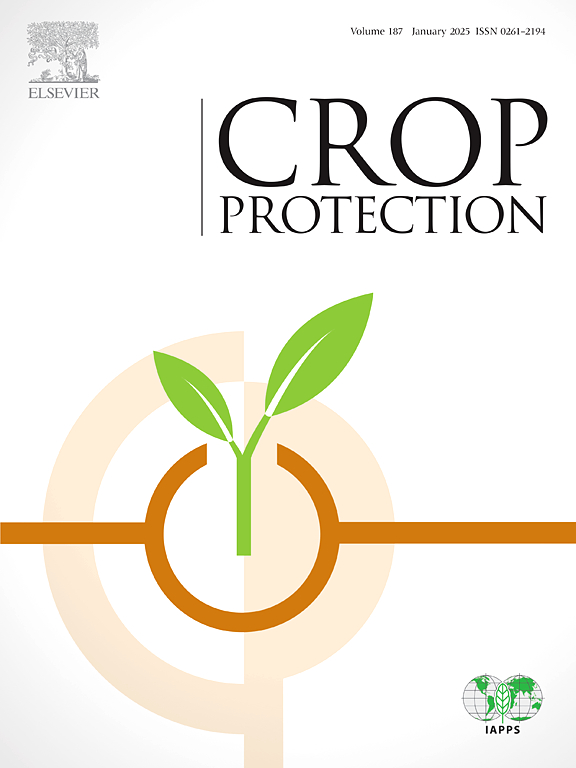快速电导率试验为苏云金芽孢杆菌产品的质量评价提供了一种可行的方法
IF 2.5
2区 农林科学
Q1 AGRONOMY
引用次数: 0
摘要
更快和更便宜的质量检测对于为用户测量微生物农药配方的质量至关重要。本研究比较了6种苏云金芽孢杆菌商业产品悬浮液的电导率与国际效价单位(IU)、农药蛋白浓度、cryy型的存在、果斑Spodoptera frugiperda和Helicoverpa zea幼虫的毒力、孢子和总活力、细菌污染物的存在、pH和湿度之间的关系。结果表明,XenTari®的活菌数最多(4.5 × 1010孢子•mL−1),而Agree®的活菌数最多。Dipel®、Agree®和XenTari®的农药蛋白含量最高(>40,000 μg mL−1)。在Agree®、XenTari®、Turinsil®和BtKrone®中均存在cry - 1型农药蛋白,只有Dipel®含有cry - 1型和2型农药蛋白。在毒力方面,使用Agree®、BtKrone®、DiPel®和XenTari®产品进行毒力测定时,frugiperda和H. zea幼虫的存活率低于2.6%。有趣的是,虽然Bacimín®具有最高的IU标签声明,但没有观察到农药蛋白和S. frugiperda幼虫的死亡率。然而,在最低浓度(<;2 × 107孢子•g−1)下检测到活细胞和孢子。这些结果有助于将产品分为零质量、中等质量和高质量类别,并建立与电导率的关系。电导率与蛋白质浓度之间存在重要关系(R2 >;0.85)或生存率(R2 >;0.81)。我们的研究结果表明,电导率可以预测苏云金芽孢杆菌商品产品的质量和性能,表明该方法是一种快速可靠的质量检测方法,可以方便农民使用。本文章由计算机程序翻译,如有差异,请以英文原文为准。
A rapid conductivity test offers a viable method to assess the quality of Bacillus thuringiensis products
Faster and less expensive quality tests are essential for measuring the quality of microbial pesticides formulations for users. In this work, the conductivity of the suspensions of six commercial Bacillus thuringiensis products was compared with the International Units of Potency (IU) in labels, the concentration of the pesticide protein, the presence of Cry-type, virulence in the larvae of Spodoptera frugiperda and Helicoverpa zea , spore and total viability, the presence of bacterial contaminants, pH, and humidity to establish relationships. The results showed that XenTari® had more viable spores (>4.5 × 1010 spores • mL−1 ), and Agree® had the most total viable cells. Dipel®, Agree®, and XenTari® had the most pesticide protein (>40,000 μg mL−1 ). The Cry-type 1 pesticide protein was present in Agree®, XenTari®, Turinsil®, and BtKrone®, and only Dipel® contained Cry-type 1 and type 2. Regarding virulence, a survival lower than 2.6% was obtained with Agree®, BtKrone®, DiPel®, and XenTari® products when S . frugiperda and H . zea larvae were used in the bioassay. Interestingly, while Bacimín® had the highest IU label claim, the pesticide protein and mortality of S . frugiperda larvae were not observed. However, viable cells and spores were detected at the lowest concentration (<2 × 107 spores • g−1 ). These results were useful for classifying products into null, medium, and high quality categories and establishing relationships with conductivity. An important relationship was found between conductivity and protein concentration (R2 > 0.85) or survival (R2 > 0.81). Our findings showed that conductivity predicts the quality and performance of commercial B. thuringiensis products, suggesting that this method is a faster and more reliable quality test that can be easily used by farmers.
求助全文
通过发布文献求助,成功后即可免费获取论文全文。
去求助
来源期刊

Crop Protection
农林科学-农艺学
CiteScore
6.10
自引率
3.60%
发文量
200
审稿时长
29 days
期刊介绍:
The Editors of Crop Protection especially welcome papers describing an interdisciplinary approach showing how different control strategies can be integrated into practical pest management programs, covering high and low input agricultural systems worldwide. Crop Protection particularly emphasizes the practical aspects of control in the field and for protected crops, and includes work which may lead in the near future to more effective control. The journal does not duplicate the many existing excellent biological science journals, which deal mainly with the more fundamental aspects of plant pathology, applied zoology and weed science. Crop Protection covers all practical aspects of pest, disease and weed control, including the following topics:
-Abiotic damage-
Agronomic control methods-
Assessment of pest and disease damage-
Molecular methods for the detection and assessment of pests and diseases-
Biological control-
Biorational pesticides-
Control of animal pests of world crops-
Control of diseases of crop plants caused by microorganisms-
Control of weeds and integrated management-
Economic considerations-
Effects of plant growth regulators-
Environmental benefits of reduced pesticide use-
Environmental effects of pesticides-
Epidemiology of pests and diseases in relation to control-
GM Crops, and genetic engineering applications-
Importance and control of postharvest crop losses-
Integrated control-
Interrelationships and compatibility among different control strategies-
Invasive species as they relate to implications for crop protection-
Pesticide application methods-
Pest management-
Phytobiomes for pest and disease control-
Resistance management-
Sampling and monitoring schemes for diseases, nematodes, pests and weeds.
 求助内容:
求助内容: 应助结果提醒方式:
应助结果提醒方式:


